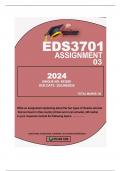Exam (elaborations)
EDS3701 ASSIGNMENT 3 DUE 28 JUNE 2024 Write an assignment explaining about the two types of diverse schools that are found in this country (Urban and rural schools). (40 marks) In your response include the following topics:
- Course
- Institution
EDS3701 ASSIGNMENT 3 DUE 28 JUNE 2024 Write an assignment explaining about the two types of diverse schools that are found in this country (Urban and rural schools). (40 marks) In your response include the following topics:
[Show more]




